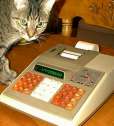National Semiconductor 4615
| Datasheet legend
Ab/c:
Fractions calculation
AC: Alternating current BaseN: Number base calculations Card: Magnetic card storage Cmem: Continuous memory Cond: Conditional execution Const: Scientific constants Cplx: Complex number arithmetic DC: Direct current Eqlib: Equation library Exp: Exponential/log functions Fin: Financial functions Grph: Graphing capability Hyp: Hyperbolic functions Ind: Indirect addressing Intg: Numerical integration Jump: Unconditional jump (GOTO) Lbl: Program labels LCD: Liquid Crystal Display LED: Light-Emitting Diode Li-ion: Li-ion rechargeable battery Lreg: Linear regression (2-var. stats) mA: Milliamperes of current Mtrx: Matrix support NiCd: Nickel-Cadmium recharg. batt. NiMH: Nickel-metal-hydrite rech. batt. Prnt: Printer RTC: Real-time clock Sdev: Standard deviation (1-var. stats) Solv: Equation solver Subr: Subroutine call capability Symb: Symbolic computing Tape: Magnetic tape storage Trig: Trigonometric functions Units: Unit conversions VAC: Volts AC VDC: Volts DC |
| ||||||||||||||||||||||||||||||||||||||||||||||||||||||||
National Semiconductor 4615
 The 4615 is a somewhat unique member of the family of programmable LED calculators manufactured by National Semiconductor in the 1970s. The machine is functionally equivalent to the Novus Mathematician PR (4515) but its appearance is different; it also has no name, nor does it carry the Novus logo.
The 4615 is a somewhat unique member of the family of programmable LED calculators manufactured by National Semiconductor in the 1970s. The machine is functionally equivalent to the Novus Mathematician PR (4515) but its appearance is different; it also has no name, nor does it carry the Novus logo.
For some reason, this machine proved surprisingly difficult to find. I once bought one from a private collector in the US, but only an empty box arrived, courtesy of the United States Postal Service. Since another Novus calculator I purchased around the same time also got lost in the mail (and no other calculators did) I was beginning to fear that there is a curse, and I might never be able to complete my Novus/National Semiconductor programmable calculator collection.
Fortunately, another US collector recently came to the rescue, and sold me a working 4615 in very nice condition. At last, I also have an original Novus wall adapter! Not to mention a manual, which is of course quite nice to have...
Like the 4515, the 4615 has a crippled RPN model. A stack only three levels deep, the lack of a stack roll function, and a Z register that's filled with zero when the stack drops seriously reduces the utility of the calculator. Plus there's only one memory register, no control transfer instructions of any kind, and the biggest of all: no exponential display!
When I wrote the Web page for the 4515, I stated that this crippled programming model makes it impossible to create an accurate implementation of the Gamma function. That is not quite true; it is actually possible to use Stirling's formula to obtain the Gamma function to 7+ degrees of precision, utilizing only a modest number of the calculator's 102 program steps.
The program below actually calculates the Gamma function's natural logarithm, which is a far more useful function to have on a calculator that cannot handle numbers larger than 108. Oh, note that magic with entering 72 1/x 5 / instead of 360 1/x. For some reason, when you enter a 0 in a program, the machine interprets it as a halt instruction. Since I've noticed this behavior on the 4515 as well, I have to conclude that this is a known fault (feature?) of this machine.
ENTER 5 + MS ln MR × MR - π 2 × MR ÷ ln 2 ÷ + 1 2 1/x MR ÷ + 7 2 1/x 5 ÷ MR ÷ MR ÷ MR ÷ - 2 5 2 1/x 5 ÷ MR ÷ MR ÷ MR ÷ MR ÷ MR ÷ + 1 M- C MR 1 M- C MR × 1 M- C MR × 1 M- C MR × 1 M- C MR × ln -

